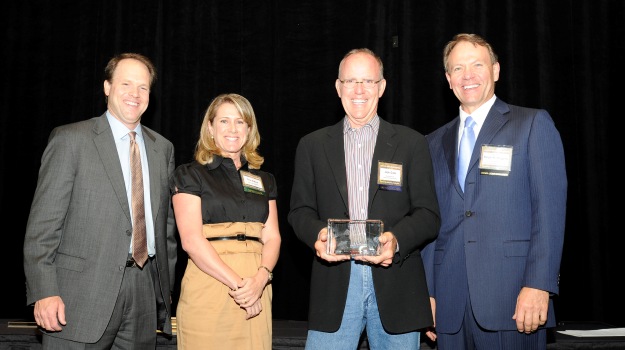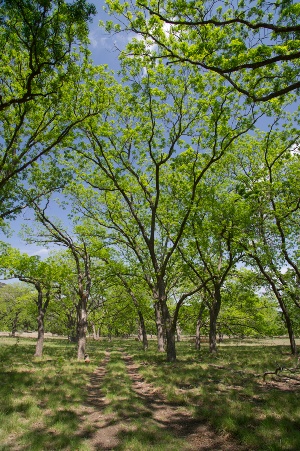
Revitalization efforts on two Texas ranches in two different ecological regions of the state have earned a Houston couple the 2013 Leopold Conservation Award, Texas's highest honor for private land conservation.
Recognized for their stewardship were Jack and Jan Cato, who in 2004 and 2006 received regional Lone Star Land Steward awards for what they have done to restore their two properties - the Buckhollow Ranch in Uvalde and Real counties on the Edwards Plateau and the Stockard-Sirianni Ranch in Frio County. That ranch is located in the South Texas Plains ecoregion.
The Leopold award, given in honor of renowned conservationist Aldo Leopold, is conferred each year by Sand County Foundation, an international non-profit organization devoted to private land conservation, in partnership with the Texas Parks and Wildlife Department (TPWD) as part of its Lone Star Land Steward Awards program. In Texas, the Leopold award is sponsored by the Lynde and Harry Bradley Fund for the Environment, Silver Eagle Distributors and the Lee and Ramona Bass Foundation.
"Winning two regional Land Steward awards and now the Leopold Award is a phenomenal accomplishment, never achieved in Texas, and a true testament to their dedication to land stewardship," TPWD Executive Director Carter Smith said of the Catos. "The Catos have dedicated an extreme amount of time and personal sacrifice in an effort to reach their wildlife and habitat management goals."
"Aldo Leopold comprehended the necessity of the private landowner providing and improving habitat. The Catos have done that in spades, and probably, with spades," said Brent Haglund, PhD, Sand County Foundation president. "We know many 'tools' have been used by the Catos to make their land a much more wildlife-rich part of Texas, and we are glad to be part of this partnership recognition."
The Catos accepted the Leopold crystal award and a check for $10,000 at the annual Lone Star Land Steward Awards dinner in Austin on May 21.
The Frio County property was inherited; the Catos have owned the Buckhollow Ranch since 1997.
"On Buckhollow Ranch, the management goals are to manage and improve the ranch for wildlife diversity, and to provide optimum wildlife habitat," retired TPWD biologist Richard B. Taylor pointed out in his nomination of the Catos for the Leopold Award. "The emphasis is on improving the native habitat through proper range and wildlife management, and to maintain healthy, native wildlife populations - with an emphasis on nongame, threatened, and endangered species."
Goals for the Stockard-Sirianni Ranch, he continued, "are to maintain as healthy an ecosystem as possible, while allowing and maintaining maximum biodiversity through innovative habitat management."
Taylor's nomination listed these accomplishments:
Due to excellent habitat management, endangered species such as the black-capped vireo, golden-cheeked warbler and Tobusch fishhook cactus are increasing on the Buckhollow Ranch. Natural springs are returning to life, and flow volumes have increased since the Catos purchased the ranch. Because of the ample ground cover that has become established through sound management practices, water penetration has improved, run-off slowed, and soil erosion noticeably diminished.
 Native plant populations have been surveyed on Buckhollow by the Texas Nature Conservancy and monitored by various agencies including TPWD and the U.S. Department of Agriculture's Natural Resources Conservation Service (NRCS). Texas Snowbell, an endemic native plant, was reintroduced several years ago in an attempt to re-establish it in its historical range.
Native plant populations have been surveyed on Buckhollow by the Texas Nature Conservancy and monitored by various agencies including TPWD and the U.S. Department of Agriculture's Natural Resources Conservation Service (NRCS). Texas Snowbell, an endemic native plant, was reintroduced several years ago in an attempt to re-establish it in its historical range.
On the Stockard-Sirianni Ranch, bi-annual helicopter surveys are conducted to assess white-tailed deer, coyotes, feral hog, javelina, turkey and quail populations. Incidental herpetological surveys have also been conducted by the landowners, TPWD, and ranch visitors. Plant surveys targeting native grasses have been conducted by South Texas Natives and TPWD. Similar to those found on the Buckhollow, bird populations are also monitored throughout the year by various bird watching groups and individuals, including the Catos, who are active birders.
The Catos have participated in a prescribed burn school and numerous wildlife seminars to better educate themselves on habitat management and environmental issues. Most of their knowledge has been directly applied to the landscape.
Water guzzlers (a mechanical water conservation device) installed throughout Buckhollow Ranch continue to benefit wildlife by improving species distribution and decreasing dependance on natural springs, rivers, and streams.
In addition, extensive stands of ashe juniper have been removed to increase spring flow, and four solar-powered water wells have either been retrofitted or drilled. Water diversion berms have been created across all hillside roads to prevent soil erosion, and one small holding tank has been created to capture seasonal water for wildlife. This has helped reduce negative impacts to sensitive areas.
As a result of extensive habitat management on Buckhollow Ranch, native grasses such as little bluestem are returning at an increasing rate, slowly replacing the non-native King Ranch bluestem that previous owners planted and allowed to increase. Browsing pressure on woody plants such as live oak has decreased dramatically, allowing ample regeneration.
At the Stockard-Sirianni Ranch, existing fences have been replaced, and a rotational grazing system instituted. This has benefitted the native habitat, and improved livestock production. In addition, a roughly 20-acre wetland has been established for resident and migratory waterfowl, complete with levees and pipelines to maintain water levels. More than 100 bird nesting boxes have been erected on this property, including bluebird boxes, screech owl boxes, wood duck boxes, purple martin houses, and bat boxes.
In addition to the work they have done on their land, the Catos have been generous in sharing their properties with others-including local residents, neighbors, conservation groups, universities, and state and federal agencies. They have been actively involved with TPWD, NRCS, the Nature Conservancy, West Texas A&M University, and Southwest Texas Junior College by allowing these agencies or institutions to use the ranch for meetings, field days, research projects, demonstrations, and educational programs.
"One of the most notable demonstration of the Catos's long-term commitment to conservation is the recent placing of the Buckhollow Ranch under a perpetual conservation easement with The Nature Conservancy," Smith noted. "The purpose of this is to preserve the natural beauty and habitat of the ranch for future generations."
Photos courtesy of Texas Parks and Wildlife.



























